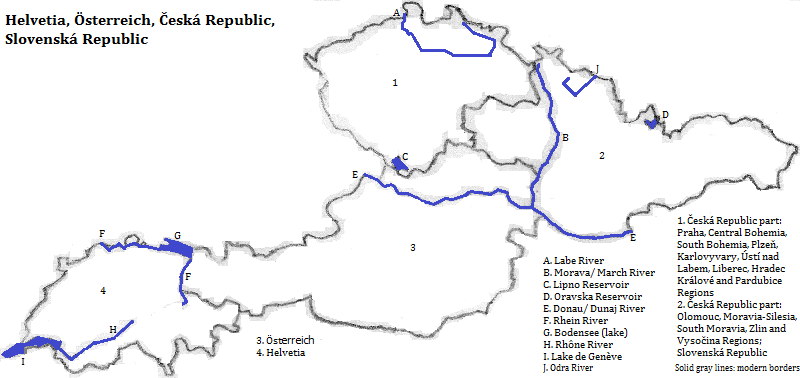
| To Duval Family Home Page | Europe |
| To Chris Home Page | |
| To Earth (Geography Home Page) |
This area is a zig zag across the center of Europe. In the west a line starts east of France and includes Helvetia and Tyrol
The Alps dominate the Switzerland-to-Steiermark line, rising above 4500 meters at Dufourspitze,
There are five World Heritage Sites that honor natural places: the Caves of Aggtelek Karst and Slovak Karst

About four in ten speak a dialect of High
There are four metropolitan areas centered in the country with more than a million residents. See Table of Austrian, Swiss, Czech and Slovak cities.
There are numerous World Heritage Sites honoring culture. In Österreich are: the City of Graz--Historical Center; Fertö/ Neusedlersee Cultural Landscape, a lakeside location that features the medieval town of Rust and Fertö Esterházy Palace; Hallstatt-Dachstein/ Salzkammergut Cultural Landscape, which honors the old city of Hallstatt, the prehistoric use of the salt deposits, and the caves in the Dachstein Mountains; the Historic Centre of Vienna (Wien); the Palace and Gardens of Schönbrunn in Wien; the Semmering Railway connecting tourist resorts in the mountains; and the Wachau Cultural Landscape at and near Krems. In the Česká Republic are: the Gardens and Castle of Kroměříž; the Historic Centre of Česky Krumlov, a medieval and Renaissance town; the Historic Center of Prague (Praha); the Historic Center of Telž, a town rebuilt in the 14th century; the Holašovice Historical Village Reservation, which preserves its medieval plan; the Holy Trinity Column in Olomouc; the Jewish Quarter and St. Procopius' Basilica in Třebíž; and Kutná Hora: Historic Town Centre with the Church of St. Barbara and the Cathedral of Our Lady at Sedlec; the Lednice-Valtice Cultural Landscape with the chateaus of Lednice and Valtice; and Litomyšl Castle, a representative of an arcade castle; the Pilgrimage Church of St. John of Nepomukat Zelená Hora at Zdár and Sázavou; the Tugendhat Villa in Brno and five locations of Prehistoric Pile Dwellings.
People arrived here from Africa many tens of thousands of years ago but much of the area was uninhabitable until the shrinking of the glaciers that covered all of Switzerland and Austria.
Eventually Indo-Europeans arrived in the area, ultimately from Україна (Ukrayina). Artifacts indicate that Scythians, speaking an Iranian language, arrived about 2600 plus years ago but left no linguistic traces. Continental Celts, also identified by artifacts, were here and elsewhere about 2500 years ago. They left tribal names on the English name for the Vlatava Basin--from the Boii--and on the former province of Raetia, giving Switzerland one of its names--from the Helvetii. But their linguistic influence has dwindled to borrowed words like reich (realm). The Roman Empire conquered up to the Danube River and Latin's legacy is shown in the French spoken in western Switzerland and the Italian of the Swiss nation's southern fringe. In the first century speakers of West Germanic dialects began arriving in Moravia, and the Germans continued expanding their influence, especially in cities, until very recent times when about three million were expelled from Czechoslovakia. Germans remain in Switzerland and Austria. Two Turkic groups, the Huns in the fifth century and the Bulgars in the eighth, invaded but left no lasting influences, any more than the Avars, a Northeast Caucasian group that ruled part of Slovakia in the mid-seventh century. Speakers of West Slavonic
The religion of early Indo-Europeans and Celts was similar to that of Celts in Britain and France. The first Roman state religion left no vestiges but the second imperial religion, Christianity, continued to expand after the western empire fell, now under Frankish sponsorship. By the tenth century the urban commmunities had converted, to be evenually followed by the country folk.
west of the Czech Republic, northwest of Austria and north of Switzerland
north of the Czeck and Slovak republics
east
southeast
south, from the west
west
1. Austria in English. The German translates as Eastern Realm.
2. Schweiz in German, Svizzera in Italian and la Suisse in French. Helvetia is used in some official contexts. Switzerland in English.
3. Czech in English.
4. Slovak in English.
5. Tirolia in English.
6. Germany in English.
7. Italy in English.
8. Hungary in English.
9. Bohemia in English. Česky is also the language's name by its speakers.
10. Poland in English.
11. Morava in Czech, March in German.
12. The Ukraine in English.
13. Part of the Monte Rosa Massif.
14. Donau in German, Dunaj in Slovak.
15. Elbe in German and English.
16. Sites within this region are: Dobšinská Ice Cave; Konlar plateau; Plešivec plateau; and the neighborhoold of Silica and Jasov.
17. Sites within this region are: Sutzica/ Bukovské vrchy; Rožok; Vihorlat; and Havešová.
18. High German includes Standard German and is the group of dialects traditionally spoken at higher elevations.
19. Deutsch in German.
20. But Czech and Slovak are mutually intelligible and these two dialects are only considered separate languages for political reasons.
21. Pile dwelling locations are listed in http://en.wikipedia.org/wiki/Prehistoric_Pile_dwellings_around_the_Alps, accessed 11/19/2013.
22. Sites are: two spot in Hronsek; Tvrdošín; Lešiny; Kežmarok; Henvatov; Ladomirová; Bodružal; and Ruská Bystrá.
23. Also known as Slavic or Schlavonic.
24. Slavic paganism here was presumably similar to that followed by their contemporaries in Україна (Ukrayina).